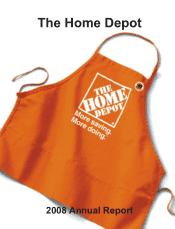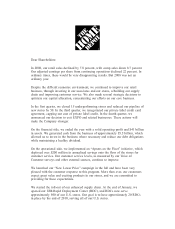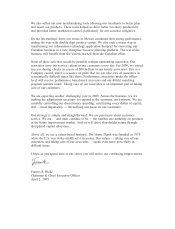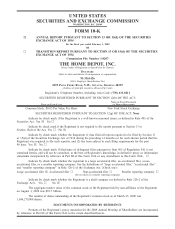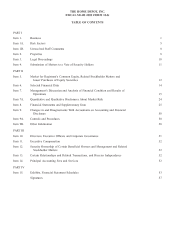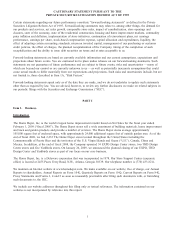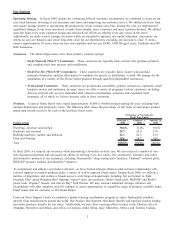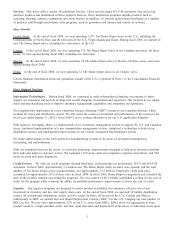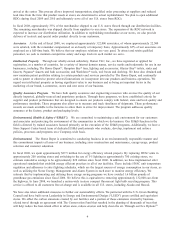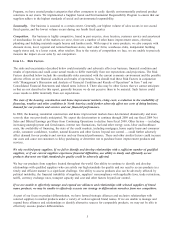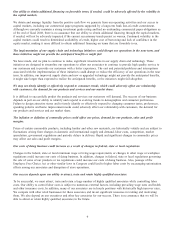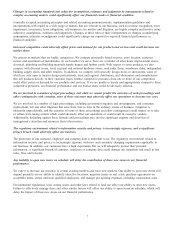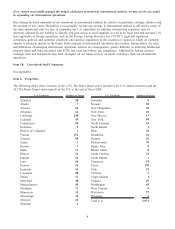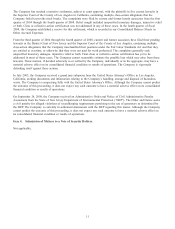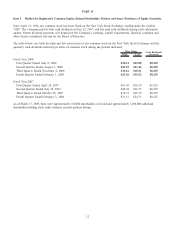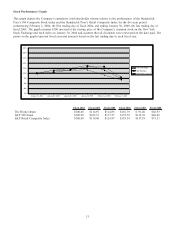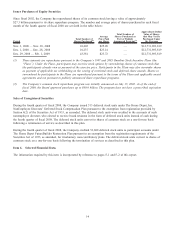Home Depot 2008 Annual Report Download - page 10
Download and view the complete annual report
Please find page 10 of the 2008 Home Depot annual report below. You can navigate through the pages in the report by either clicking on the pages listed below, or by using the keyword search tool below to find specific information within the annual report.Program, we have created product categories that allow consumers to easily identify environmentally preferred product
selections in our stores. We implemented a Supplier Social and Environmental Responsibility Program to ensure that our
suppliers adhere to the highest standards of social and environmental responsibility.
Seasonality. Our business is seasonal to a certain extent. Generally, our highest volume of sales occurs in our second
fiscal quarter, and the lowest volume occurs during our fourth fiscal quarter.
Competition. Our business is highly competitive, based in part on price, store location, customer service and assortment
of merchandise. In each of the markets we serve, there are a number of other home improvement stores, electrical,
plumbing and building materials supply houses and lumber yards. With respect to some products, we also compete with
discount stores, local, regional and national hardware stores, mail order firms, warehouse clubs, independent building
supply stores and, to a lesser extent, other retailers. Due to the variety of competition we face, we are unable to precisely
measure the impact on our sales by our competitors.
Item 1A. Risk Factors.
The risks and uncertainties described below could materially and adversely affect our business, financial condition and
results of operations and could cause actual results to differ materially from our expectations and projections. The Risk
Factors described below include the considerable risks associated with the current economic environment and the possible
adverse effects on our financial condition and results of operations. You should read these Risk Factors in conjunction
with “Management’s Discussion and Analysis of Financial Condition and Results of Operations” in Item 7 and our
Consolidated Financial Statements and related notes in Item 8. There also may be other factors that we cannot anticipate
or that are not described in this report, generally because we do not perceive them to be material. Such factors could
cause results to differ materially from our expectations.
The state of the housing, construction and home improvement markets, rising costs, a reduction in the availability of
financing, weather and other conditions in North America could further adversely affect our costs of doing business,
demand for our products and services and our financial performance.
In 2008, the housing, residential construction and home improvement markets have deteriorated dramatically and more
severely than was previously anticipated. We expect the deterioration to continue through 2009 and our fiscal 2009 Net
Sales and Diluted Earnings per Share from Continuing Operations to decline from fiscal 2008. Other factors — including
increasing unemployment and foreclosures, interest rate fluctuations, fuel and other energy costs, labor and healthcare
costs, the availability of financing, the state of the credit markets, including mortgages, home equity loans and consumer
credit, consumer confidence, weather, natural disasters and other factors beyond our control — could further adversely
affect demand for our products and services and our financial performance. These and other similar factors could increase
our costs and cause our customers to delay purchasing or determine not to purchase home improvement products and
services.
We rely on third party suppliers. If we fail to identify and develop relationships with a sufficient number of qualified
suppliers, or if our current suppliers experience financial difficulties, our ability to timely and efficiently access
products that meet our high standards for quality could be adversely affected.
We buy our products from suppliers located throughout the world. Our ability to continue to identify and develop
relationships with qualified suppliers who can satisfy our high standards for quality and our need to access products in a
timely and efficient manner is a significant challenge. Our ability to access products also can be adversely affected by
political instability, the financial instability of suppliers, suppliers’ noncompliance with applicable laws, trade restrictions,
tariffs, currency exchange rates, transport capacity and cost and other factors beyond our control.
If we are unable to effectively manage and expand our alliances and relationships with selected suppliers of brand
name products, we may be unable to effectively execute our strategy to differentiate ourselves from our competitors.
As part of our focus on product differentiation, we have formed strategic alliances and exclusive relationships with
selected suppliers to market products under a variety of well-recognized brand names. If we are unable to manage and
expand these alliances and relationships or identify alternative sources for comparable products, we may not be able to
effectively execute product differentiation.
5

